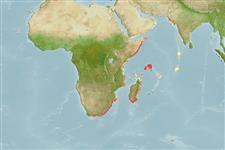Environment: milieu / climate zone / depth range / distribution range
Ecología
marino. Subtropical
Distribución
Países | Áreas FAO | Ecosistemas | Ocurrencias, apariciones | Point map | Introducciones | Faunafri
Indian Ocean: widely distributed, extending to Cape Agulhas, South Africa.
Tamaño / Peso / Age
Maturity: Lm ? range ? - ? cm
Max length : 8.0 cm TL macho / no sexado; (Ref. 6615)
Short description
Claves de identificación | Morfología | Morfometría
Espinas dorsales (total) : 4 - 7; Radios blandos dorsales (total) : 12 - 17; Espinas anales: 1; Radios blandos anales: 21 - 28. Translucent with silver lower head and band along side to silver spot on caudal peduncle and viscera enclosed in silver.
Found in large numbers in boiling surf, close to shoreline. Occurs in large aggregations (Ref. 90102).
Life cycle and mating behavior
Maturities | Reproducción | Spawnings | Egg(s) | Fecundities | Larva
Ivantsoff, W., 1986. Notocheiridae. p. 384. In M.M. Smith and P.C. Heemstra (eds.) Smiths' sea fishes. Springer-Verlag, Berlin. (Ref. 6615)
IUCN Red List Status (Ref. 130435)
Threat to humans
Harmless
Human uses
Herramientas
Special reports
Download XML
Fuentes de Internet
Estimates based on models
Preferred temperature (Ref.
123201): 21.3 - 27.5, mean 26.8 °C (based on 202 cells).
Phylogenetic diversity index (Ref.
82804): PD
50 = 0.5625 [Uniqueness, from 0.5 = low to 2.0 = high].
Bayesian length-weight: a=0.00389 (0.00180 - 0.00842), b=3.12 (2.94 - 3.30), in cm total length, based on all LWR estimates for this body shape (Ref.
93245).
Nivel trófico (Ref.
69278): 3.1 ±0.3 se; based on size and trophs of closest relatives
Fishing Vulnerability (Ref.
59153): Low vulnerability (10 of 100).
